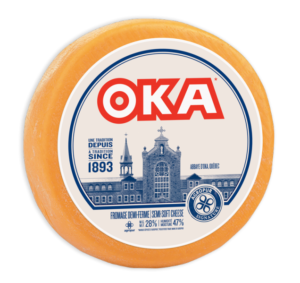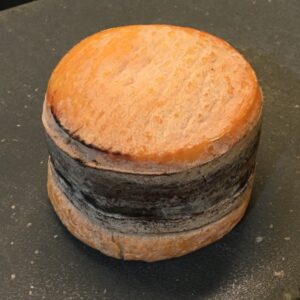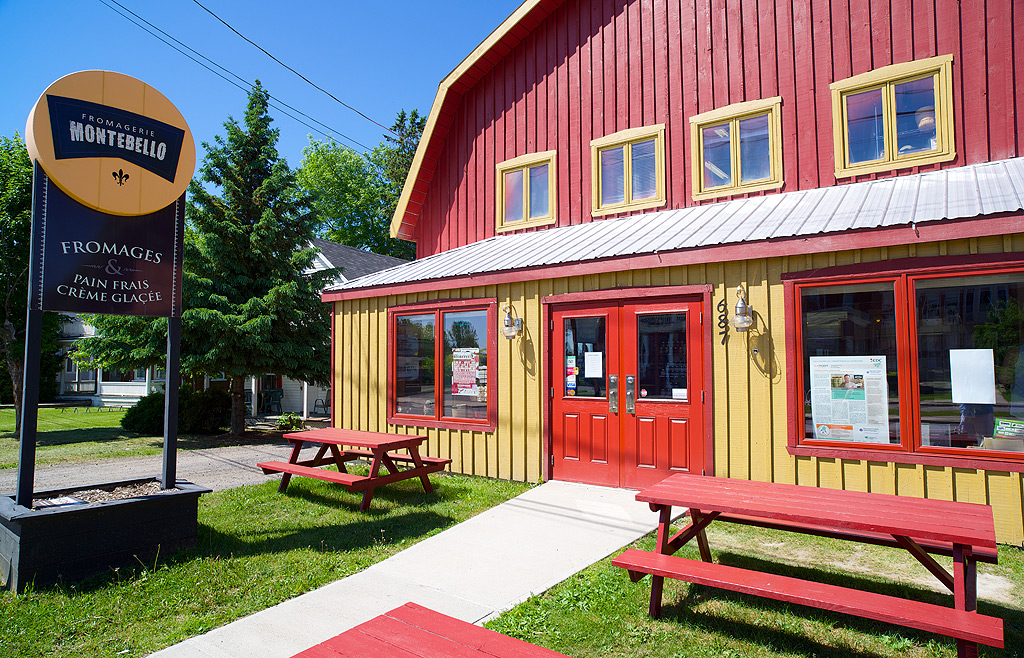
Flashback to November, 1960, Deux Montagnes, Québec:
A young monk entered the guesthouse dining room at Abbey of Notre Dame du Lac bearing a large platter. He gently placed it in the centre of the table where eight of us were sitting. The platter appeared to be piled high with big chunks of pale yellow pineapple.
Pineapple in the middle of November in a Trappist monastery in Québec? I was mystified. Despite the no-talking rule, I turned to the man on my left and whispered: “Qu’est-ce que c’est?”
“Fromage” was his curt reply, followed by “Ssshhhh!”
Fromage? I could handle cheese first thing in the morning, my first morning as a guest at the monastery. After the blessing and signal to begin eating, I didn’t hesitate to reach for a big chunk and popped it in my mouth.
“Oh, my goodness!” I could hardly hold back exclaiming out loud. I had never tasted a cheese so buttery, so creamy, so delicious. So many more chunks followed the first that I hardly had room for the farm-fresh scrambled eggs that were served for breakfast.
And so it came to pass that I was introduced to Oka cheese when the Trappists still made it. Indeed, that morning was the moment my passion for artisan cheese was ignited.
Flashback further, to February, 1893:
Brother Alphonse Juin arrives at the Abbey of Notre Dame du Lac—known as Oka Abbey after the small village on the northern bank of the Ottawa River, northwest of Montreal, on Lake of Two Mountains, where the Ottawa has its confluence with the St. Lawrence River.

The monastery was struggling, unable to make ends meet. Brother Alphonse had been sent from the Abbaye de Bellefontaine in France (from which the Oka monks originated) with a recipe for Port-du-Salut cheese created by Trappists a few years earlier. Brother Alphonse tweaked and adjusted Port-du-Salut recipe, creating a unique Quebec cheese that went on to win first prize at the Montreal Exhibition that same year.
Imagine the shock of judges at the exhibition to be presented with a unique semi-soft, washed-rind cheese when only cheddars ruled the day!
The Oka Trappist cheese continued to win awards and recognition. Soon, it became immensely popular, assuring the financial stability of the monastery. Today, it’s clearly the most iconic of all Canadian cheeses, known the world over.
Fast forward to 1981:
Agropur, Canada’s biggest dairy co-operative purchases the Oka cheesemaking operation from the Trappist monks and builds a state-of-the-art plant next door to the monastery. Eventually, an expansive retail store is opened, showcasing Oka cheeses and artisan products from across Québec. (Which makes a visit to Oka really worth your while.)
Over time, the product line is expanded beyond the original Oka cheese to include Oka Classique, Light, Raclette, L’Artisan, L’Artisan Smoke, Mushrooms, Ashed and Brother Alphonse.
The original Oka with the somewhat plain label remains my favourite and is closest to what I recall first tasting so many years ago.
Fast forward to October, 2006:
The monks, by now world-famous, announce they are selling Oka Abbey and moving to a smaller home in the forest 100 kilometres northeast of Montreal.
A local non-profit group will transform the monastery into a tourism and education centre. The Abbey of Notre Dame du Lac includes a large grey stone monastery and a dozen buildings nestled on 270 hectares of forested land. The monks also own farmland.
Thousands of people from around the world have visited the abbey to attend mass, meditate and enjoy the bucolic peace and quiet. The abbey has long welcomed men and women seeking short-term retreats, and also runs a monastic guest program for men interested in experiencing monastic life.
At its peak, the abbey was the permanent home to as many as 200 monks, who belong to the Order of Cistercians of the Strict Observance, commonly known as the Trappists. But the community has dwindled over the past generation, and only 28 monks, the majority of whom are older than 70, live at the monastery.
Fast forward to today:
Oka is semi-soft, washed-rind cheese with an edible copper-orange rind. It has a distinct aroma—some might call it pungent, especially as the cheese ages—and a relatively mild, creamy and buttery flavour.
My tasting notes say: Creamy and sweet. Nice touch of umami. Hints of mushrooms and nuts. Velvety and supple mouthfeel.

While Oka was once made from raw milk fresh from the abbey’s farm, today it’s made from pasteurized milk. Master cheesemakers used to wash the wheels with brine by hand to promote proper aging. These days, the process is facilitated by machines that allow for a more homogenous production and limit rind contamination.
The secret to the flavour and iconic aroma lies in the complex microbiology of the rind, found only in the cellars of the former monastery. The cheese is made in a state-of-the-art plant next door but still aged in the old monastery cellars.
Meanwhile, deep in the forest northeast of Montreal:
When the Trappists left Oka to escape suburban sprawl, they left behind an oversized, aging building. Their new Trappist abbey, L’Abbaye Val Notre-Dame, nested in the forests and rolling hills of the Lanaudiere region and known for its cutting-edge ecological architecture, has been heralded as the 21st-century monastery. But, more importantly, it has become pivotal in the monks’ sweeping spiritual renewal.

Moving here has made the Trappists rethink their relationship with their environment, as the community must earn its living from manual work. It’s no longer possible to take care of 3,000 apple trees or 2,500 sugar maples like they used to do in Oka. The monks have instead learned to tap the nurturing powers of the surrounding 187-acre forest.
Since 2014, the monks have transformed and commercialized edible forest products. They have discovered the riches of the abbey’s backwoods. At the monastery’s gift shop, one can find larch needles, marinated fiddleheads and products made from milkweed, next to the more usual chocolates and caramels. For the Val Notre-Dame monks, the forest holds a precious bounty. Occasionally, they even share a meal made entirely of ingredients harvested on their estate.
Meanwhile, out in Manitoba, the Oka story takes a twist:
In their own way, Winnipeg chefs Dustin Peltier and Rachel Isaak are continuing the Oka tradition with the recipe that was entrusted to Brother Alberic at Our Lady of the Prairies Monastery at Holland, Manitoba, and he in turn passed it on to the chefs after training Dustin in cheesemaking.
—Georgs Kolesnikovs
Georgs Kolesnikovs is Cheese-Head-in-Chief at CheeseLover.ca. He’s never met a cheese he didn’t like . . . well, hardly ever.
 My love affair with Boursin started maybe 40 years ago, when it was still an imported delicacy from France, so creamy and so garlicky. Now made in Canada, and even though manufactured on an industrial scale, the garlic and herb Boursin is very similar to what I recall enjoying so many years ago.
My love affair with Boursin started maybe 40 years ago, when it was still an imported delicacy from France, so creamy and so garlicky. Now made in Canada, and even though manufactured on an industrial scale, the garlic and herb Boursin is very similar to what I recall enjoying so many years ago. We seasoned the chicken with salt, pepper, garlic powder, onion powder and paprika and stuffed the breast with Boursin, sautéed spinach and a dusting of Parmigiano. Baked at 375F for 30 minutes. Served with a garden salad.
We seasoned the chicken with salt, pepper, garlic powder, onion powder and paprika and stuffed the breast with Boursin, sautéed spinach and a dusting of Parmigiano. Baked at 375F for 30 minutes. Served with a garden salad.



